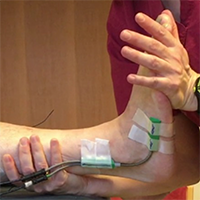Comparison of Spasticity in Spinal Cord Injury and Stroke Patients using Reflex Period in Pendulum Test

Accepted: 11 March 2020
HTML: 20
All claims expressed in this article are solely those of the authors and do not necessarily represent those of their affiliated organizations, or those of the publisher, the editors and the reviewers. Any product that may be evaluated in this article or claim that may be made by its manufacturer is not guaranteed or endorsed by the publisher.
Spasticity is a motor impairment present in patients with both stroke and spinal cord injury. In this research, the results from the Wartenberg pendulum test, performed on stroke and spinal cord injury patients using goniometers and electromyogram recordings of the quadriceps, were reviewed and a new parameter to quantify spasticity was extracted. The Reflex Period (RP) of the pendulum test was defined as the time span from 50% of the maximum velocity of the leg swing to the activation of muscle contraction in the quadriceps, determined from the EMG. The results suggest that the reflex period in stroke patients is generally shorter than in those suffering from spinal cord injury.
Li S, Francisco G E. New insights into the pathophysiology of post-stroke spasticity. Frontiers in human neuroscience 2015; 10;9:192. doi: 10.3389/fnhum.2015.00192. DOI: https://doi.org/10.3389/fnhum.2015.00192
Lance JW. “Symposium synopsis” in Spasticity: Disordered motor control. Year Book Medical Publishers 1980; 485:494.
Kuo CL, Hu GC. Post-stroke Spasticity: A Review of Epidemiology, Pathophysiology, and Treatments. International Journal of Gerontology 2018; 12;280:284. DOI: https://doi.org/10.1016/j.ijge.2018.05.005
Burke D, Wissel J, Donnan GA. Pathophysiology of spasticity in stroke. Neurology 2013;15;80. doi: 10.1212/WNL.0b013e31827624a7 DOI: https://doi.org/10.1212/WNL.0b013e31827624a7
Booth CM, Cortina-Borja MJ, Theologis TN. Collagen accumulation in muscles of children with cerebral palsy and correlation with severity of spasticity. Developmental Medicine & Child Neurology 2001;43(5):314-20. DOI: https://doi.org/10.1017/S0012162201000597
Romanini L, Villani C, Meloni C, Calvici V. Histological and Morphological aspects of Muscle in Infantile Cerebral Palsy. Italian Journal of Orthopaedics and Traumatology 1989; 15(1):87-93.
Lieber RL, Steinman S, Barash IA, Chambers H. Structural and Functional Changes in Spastic Skeletal Muscle. Muscle and Nerve 2004; 29(5):615-27. DOI: https://doi.org/10.1002/mus.20059
Stecco A, Stecco C, Raghavan P. Peripheral Mechanisms Contributing to Spasticity and Implications for Treatment. Current Physical Medicine and Rehabilitation Reports 2014; 2(2): 121-27. DOI: https://doi.org/10.1007/s40141-014-0052-3
Wartenberg R. Pendulousness of the Leg as a Diagnostic Test. Neurology 1951;1:18-24. DOI: https://doi.org/10.1212/WNL.1.1.18
Fowler EG, Nwigwe AI, Wong Ho T. Sensitivity of the Pendulum Test for Assessing Spasticity in Persons with Cerebral Palsy. Developmental Medicine & Child Neurology 2000;42:182-9. DOI: https://doi.org/10.1017/S0012162200000323
Syczewska M, Lebiedowska MK, Pandyan AD. Quantifying Repeatability of the Wartenberg Pendulum Test Parameters in Children with Spasticity. Journal of Neuroscience Methods 2009;178:340-4. DOI: https://doi.org/10.1016/j.jneumeth.2008.12.031
Whelan A, Sexton A, Jones M, O’Connel C, McGibbon CA. Predictive Value of the Pendulum Test for Assessing Knee Extensor Spasticity. Journal of NeuroEngineering and Rehabilitation 2018;15;68. DOI: https://doi.org/10.1186/s12984-018-0411-x
Bajd T, Vodovnik L. Pendulum Testing of Spasticity. Journal of Biomedical Engineering 1984;6(1):9-16. DOI: https://doi.org/10.1016/0141-5425(84)90003-7
White H, Uhl TL, Augsburger S, Tylkowski C. Reliability of the three-dimensional pendulum test for able-bodied children and children diagnosed with cerebral palsy. Gait and Posture 2007; 26:97-105. DOI: https://doi.org/10.1016/j.gaitpost.2006.07.012
Bohannon RW, Harrison S, Kinsella-Shaw J. Reliability and Validity of Pendulum Test Measures of Spasticity obtained with the Polhemus Tracking System from Patients with Chronic Stroke. Journal of NeuroEngineering and Rehabilitation 2009; 6;30. DOI: https://doi.org/10.1186/1743-0003-6-30
Guðfinnsdóttir HK. Evaluation of tSCS treatment for the alleviation of lower limb spasticity. Reykjavík, 2016.
PAGEPress has chosen to apply the Creative Commons Attribution NonCommercial 4.0 International License (CC BY-NC 4.0) to all manuscripts to be published.


 https://doi.org/10.4081/ejtm.2019.8907
https://doi.org/10.4081/ejtm.2019.8907



